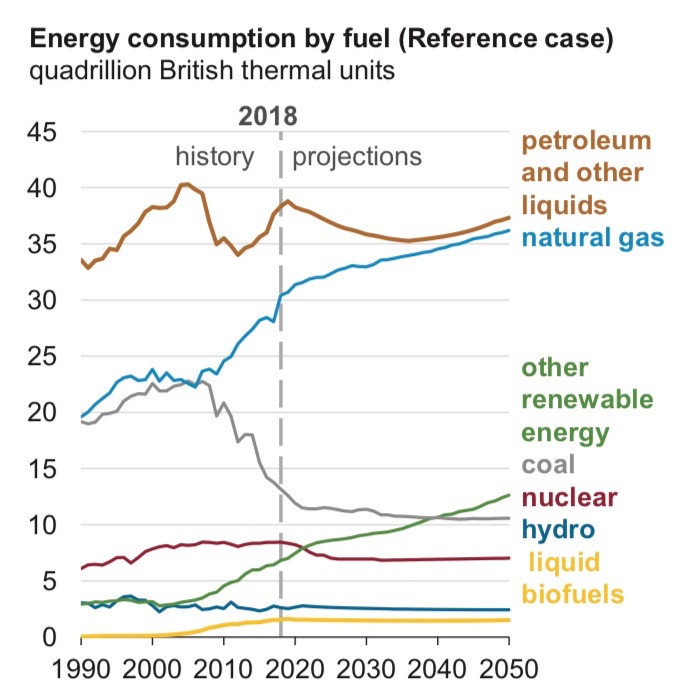Department of Energy Forecast Indicates Future of Oil and Natural Gas Is Very Bright
Given all the “Green New Deal” hype, one might be inclined to believe the future for oil and natural gas is very bleak. But the opposite is actually true.
The U.S. Department of Energy (DOE) recently released a report that shows fossil fuels – primarily oil and natural gas – will likely meet 79 percent of our energy needs in 2050. That represents just a one percent decline from fossil fuels’ energy consumption share last year.
As the following American Enterprise Institute graphics show, reports of oil and natural gas’ demise have no basis in reality.


Notably, the DOE’s projections aren’t dictated by who happens to occupy the White House. In fact, similar projections date back to the Obama administration. The DOE’s projections are based on cold, hard facts – and the fact remains that wind and solar’s fundamental limitations will keep abundant, dependable and affordable oil and natural gas in high demand for decades to come.
First and foremost, wind and solar offer no alternative whatsoever to oil and natural gas use in the industrial sector, or the roughly 6,000 petroleum-based products that are essential to our everyday lives. And as Real Clear Energy’s Jude Clemente recently noted, “perhaps the world’s greatest energy irony is that oil and petrochemicals themselves are integral to renewables, electric cars, and the overall ‘energy transition’ itself.”
Indeed, petroleum and petroleum products are needed to manufacture solar panels, wind turbines, batteries, thermal insulation and electric vehicles. They are also needed to power the heavy machinery and large trucks necessary to mine the rare earth metals needed for electric car batteries.
But what about power generation? Many don’t realize that wind and solar are intermittent electricity-generation sources that must be backed up by natural gas generation when the wind isn’t blowing or the sun isn’t shining. It is for this simple reason that the head of one of the largest utilities in the United States, Excel CEO Ben Fowke, recently said, “The grid can’t be 100 percent renewable.”
So even assuming that electric vehicles will one day replace vehicles with internal combustion engines, their batteries would be charged by power that is at least partially generated by fossil fuels.
Based on current battery storage technology, Fowke acknowledges the maximum potential share of power generation generated by wind and solar would be 80 percent. And a recent Wood Mackenzie report finds that even in areas of the country with a “decent” mix of wind and solar potential, those places can only get to 50 percent wind and solar penetration without struggling. There is currently no complex electric power system in the world that operates with a wind or solar supply mix greater than 30 percent.
The fact remains that petroleum has been the largest source of United States energy consumption since 1950 for many reasons — the same reasons the DOE projects it will retain that title out to 2050 and beyond. The following EIA graphic pretty much tells the tale.

We are simply going to need a lot of oil and natural gas in the decades to come. And the only alternative to producing it here is importing in from countries that would love nothing more than to have us under their collective thumbs. Fortunately, the United States is positioned to limit, if not eliminate, the latter scenario like never before. Already the world’s undisputed leader in both oil and natural gas production, the DOE expects us to become a net exporter of energy next year and continue to retain that status through at least 2050.
Long-coveted energy independence is about to become the new normal.
To be clear, no energy source is perfect. But the United States has reduced greenhouse gas emissions more than any other country so far this century, all while growing economy an unprecedented 10 consecutive years. The only realistic path toward continued emissions reductions and economic stability is an all-of-the-above energy mix that includes natural gas, nuclear, hydropower and some form of carbon capture. “Green New Deal” advocates reject all of these in favor of exclusive use of limited wind and solar technologies that are currently meeting just three percent of our energy needs.
This is why when it comes to the “Green New Deal,” the rhetoric doesn’t reflect reality. Instead, reality reflects the myriad of reasons Americans need to support U.S. oil and natural gas development moving forward.
